Key Takeaway: Pristine, green and progressive, Norway keeps its air clean thanks to hydropower and banning fossil fuels to heat buildings. But that hasn’t stopped the nation from exporting vast quantities of oil and gas around the world, and some say a reckoning is coming.
Like the millions of tourists who flock there each year, David Boyd was struck by Norway’s natural splendor.
Visiting for work, not pleasure, the United Nations special rapporteur for human rights and the environment found plenty to admire, judging by the report he published in September. In it, he gushes about “this beautiful Nordic nation” and pays tribute to its “strong environmental record.”
Thanks to hydropower, its electricity system is nearly emissions-free, he remarks. Fossil-fuel use is banned for heating buildings. Newly sold vehicles are likelier to be electric than in any other country.
But there is a toxic side to the story. Belying its green appearance, Norway is a giant among the world’s producers of oil and gas, the main contributors to carbon emissions after coal. Extracting those fuels generates a quarter of Norway’s own emissions, says Climate Analytics, a scientific research group backed by Germany.
But most of the harm occurs when these fuels pour into other countries in unhealthy doses. In 2017, Norway was the world’s largest exporter of natural gas bar Russia, according to Norwegian government figures. Today, it supplies about 2% of the world’s oil supply.
Boyd calls it Norway’s environmental paradox — the country’s environmental stewardship is at odds with the fossil fuel extraction underpinning the economy. Worse, “its leadership in some aspects of addressing the global climate emergency is enabled by wealth generated by a large petroleum industry,” he writes.
Charges of hypocrisy have flown. Norway is the health fanatic enriched by selling junk food to his neighbors. Norway exports ten times more emissions than it generates domestically, according to a 2017 report by Oil Change International, a green lobby group. The country’s sales of fossil fuels make it the planet’s seventh-largest exporter of emissions.
Norway’s government has taken some steps this year to limit its economic dependency on fossil fuels. The country’s oil-funded sovereign wealth fund, the world’s largest at $1 trillion, earlier this month decided to gradually end its investments in companies that seek and drill for oil.
But critics say that this initiative and some environmental efforts, such as the construction of an electric plane and putting more electric cars on the road, are window dressing. The sovereign wealth fund move is chiefly about making Norway less vulnerable to a permanent oil price decline that financial advisors anticipate.
There are no plans, notably, to sell the government’s 67% stake in energy giant Equinor, whose sales rose 30% last year, to almost $80 billion. “They plan to get out of selling combustion cars by 2025 but why not earlier?” Andrzej Ancygier, a senior energy and climate policy analyst with Climate Analytics, said in an interview with Karma, noting that more than half the vehicles sold in Norway last year were gas-powered.
The wealth fund, the Government Pension Fund Global, could do more to invest in low-carbon solutions, Ancygier added. “With the weight they have, they can move mountains,” he said.
Pillar of the Economy
Despite the good intentions, Norway’s authorities can’t simply turn off the taps. As recently as 2017, the oil-and-gas sector accounted for 9% of jobs, 12% of GDP, 13% of government revenues and 37% of exports, according to the CIA World Factbook. What is needed, said Oil Change International the same year, is a managed, “climate safe” decline in production that also provides a suitable transition period for affected workers and communities.
The opposite is now happening. Norwegian oil production has been rising since 2014, and gas production is near an all-time high. Total production is forecast to increase between 2020 and 2023 and “will then approach the record year of 2004,” predicts the Norwegian Petroleum Directorate.
“If Norway does not lead the way, what country will?”
Oil “will be an important and major industry in Norway for many years to come,” according to a March statement from the government, which said it was unavailable to answer questions for this story by phone or email. “By delaying necessary action, Norway increases the odds of a chaotic, unnecessarily disruptive shutdown at a later date in a scramble to avert climate disaster,” says Nathan Lemphers, a senior campaigner with Oil Change International.
If Norway cut production, other oil-producing countries would fill the void, and the Norwegian economy would suffer. Without more demand for renewables, the environment could take more punishment, warns Ancygier, because shale alternatives are dirtier than Norwegian gas. The answer, he insists, lies in reducing consumption.
Lemphers is unsympathetic. “It is a common misconception that if Norway extracts less oil and gas, another country would extract the same amount instead,” he says, arguing such “leakage” effects are typically partial. The most cost-effective approach is to reduce two thirds of emissions through supply-side measures such as cuts in production, said researchers from Norway’s own statistics bureau in a 2017 paper.
“Norway is the oil-and-gas producer with the highest per-capita GDP in the world,” says Lemphers. “If Norway does not lead the way, what country will?”






















